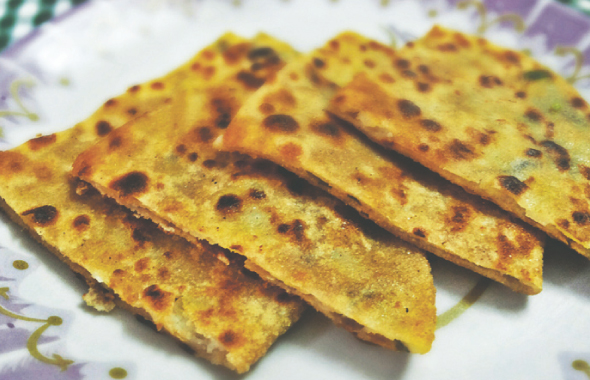Mama’s Punjabi Recipes – Kele Da Masala Parantha (Banana Stuffed Parantha)
There are many types of paranthas, and it seems that you can only be limited by your imagination and skill as a cook with what you can stuff them with. I have even made them with sugar and the grated Cheddar cheese, they come out delicious, especially after the cheese has melted inside. Although there are paranthas made all over India, the Punjabi style paranthas are well-known all over the world for their buttery whole wheat dough, generous tasty fillings and soft edges.
This recipe for a kela (banana) parantha is a modern-day variation and is especially good since it can be kept unrefrigerated for several days and can be eaten on long journeys, like on a plane or bus trip or a long train ride, which many people still take in India. It is a good source of quick energy and nourishment.
Bananas are an ideal fruit that many people enjoy for its ease of peeling and because it can fill you up quickly. But it is also a very good source of potassium, which is important to many people with high blood pressure. Bananas are also high in Vitamins B6 and C and are high in carbohydrates. In South India, people use the banana leaves as plates for eating meals.
My masala banana parantha recipe uses methi in it to add some unique taste, though it is not essential. It is a little like making banana nut bread, except without the nuts and the sugar, and can be eaten by itself or with your favorite condiments.
Ingredients:
500gm kanak (gehon) ka atta (wheat flour)
250gm besan (gram flour)
2 bunches of fresh methi (fenugreek)
1 large kela (banana) – soft and ripe, peeled and mashed
3 tbsp tael (olive oil or vegetable oil)
½ cup plain dahi (yogurt)
1 1/2 cups pani (water)
Spices to taste: namak (salt), mirch (red pepper)
Directions:
1. Wash the stems of methi and dry with a soft cloth. Remove the tougher stalks and then finely chop the methi. If fresh methi is not available, use dried methi, but first soak it for 10 minutes to let the dirt and hard stems separate and settle then skim the methi from the top. Use at least one cup of methi for the entire flour.
2. Mix the atta and the besan together, adding the salt and mirch and the mashed banana. Add the methi, oil and yogurt and knead well. You do not need to add water to make the dough, which should be soft but not runny.
3. Leave the dough in the refrigerator for 30 minutes. You should not cook the paranthas right after making the dough as they will come out hard. The oil and yogurt will help to make these paranthas soft.
4. Dab your hands with a little oil and then break off small pieces of the dough. Make these into small paade (balls) and then roll out into an 8 to 10 inch circle.
5. Put a small dab of oil on a hot tava (hotplate or skillet) and place the flattened dough on. When it turns color a little, turn the pancake over. Put another dab of oil on the tava and then turn it over again till it is fully cooked. These paranthas will not puff up and when they have some dark brown spots on them, it means they are cooked.
6. Because of the methi and yogurt, these paranthas are quite soft and easy for older people to eat. Try these with butter or yogurt for best taste.
MAMA’S TIP OF THE WEEK
KEEPING BANANAS FIRM & WITHOUT SPOTS
Often, the bananas that we buy in the grocery store ripen quickly at home, especially as they are either placed in a basket or hung on a hook on the kitchen counter. People are warned not to keep them in the refrigerator as the skin of the bananas will turn brown and the inside meat will become a little harder.
I have found that the way to keep bananas fresh longer is by keeping them in the fridge but covered in a closed plastic bag. This allows the air around the fruit to act an insulator and maintain a constant temperature which will not allow the bananas to turn brown, get spots, the outer skin to crack open or the fruit to dry up and harden.
Shakuntla Malhotra is a skilled cook of Punjabi dishes made in the old-fashioned style that she learnt as a young woman in her ancestral home in Lyallpur, India before it became part of Pakistan after the Partition in 1947. People have often admired her cooking for its simplicity and taste that comes with each mouthful. Even in her mid-eighties, she continues to cook daily and agreed to share some of her delectable Punjabi recipes.


